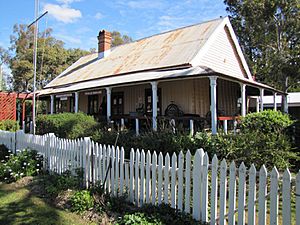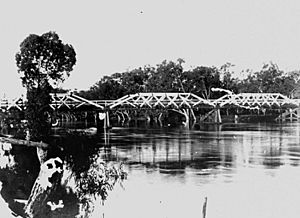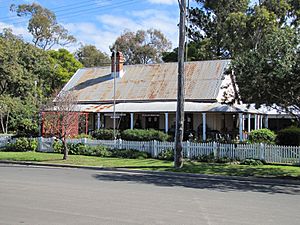Customs House Museum facts for kids
Quick facts for kids Customs House Museum |
|
|---|---|

Customs House Museum, 2012
|
|
| Location | 1 McLean Street, Goondiwindi, Goondiwindi Region, Queensland, Australia |
| Design period | 1840s–1860s (mid-19th century) |
| Built | 1860s circa – 1900s circa |
| Official name: Customs House Museum | |
| Type | state heritage (built) |
| Designated | 21 October 1992 |
| Reference no. | 600530 |
| Significant period | 1860s-1900s circa (fabric, historical) |
| Significant components | residential accommodation – main house, kitchen/kitchen house, residential accommodation – housing |
| Lua error in Module:Location_map at line 420: attempt to index field 'wikibase' (a nil value). | |
The Customs House Museum is a special old building in Goondiwindi, Australia. It used to be a house and now it's a museum. It's located right by the main bridge over the Macintyre River. This building is important because it's listed on the Queensland Heritage Register, which means it's protected for its history. It was built a long time ago, between the 1860s and early 1900s.
Contents
A Look Back: Goondiwindi's Early Days
Goondiwindi started as a simple camp for teamsters, who were like truck drivers of the past. They would stop here because it was where three big farms met. This area was first explored in 1827 by a botanist named Allan Cunningham.
How Goondiwindi Grew
In the 1830s, farmers from New South Wales started moving north, looking for new land for their sheep. They set up farms on the Darling Downs. Supplies for these farms came from the south, not from Brisbane. The teamsters bringing these supplies would camp on a small hill in the Goondiwindi area. This hill slowly became a small town.
At first, government services like the police and post office were at a place called Callandoon. But people wanted to buy land in Goondiwindi. So, in 1858, they asked the government to survey the area. The first land sales in Goondiwindi happened in August 1860.
Queensland Becomes a Separate Colony
By 1860, Queensland had become its own separate colony from New South Wales. The Macintyre River then became part of the border between the two. This meant that goods crossing the river from New South Wales into Queensland might need to pay a special tax called "customs duty."
In 1861, the post office moved to Goondiwindi, and a courthouse and police station were built. The land where the Customs House Museum stands today was first bought in 1863 by Matthew Maher, a mail contractor. Later, in 1872, it was sold to Samuel Droughton, who was also a mail contractor and dairyman. His family owned it until 1901.
The Role of Customs Houses
When Queensland became a separate colony, it wanted to collect taxes on goods coming in from New South Wales. This was called "customs duty." At first, not many goods came through the inland areas, so collecting these taxes wasn't a big deal.
Why Customs Duties Were Important
As more people moved into Queensland, the government realized it was losing a lot of money because goods were coming in without paying duty. For example, taxes on tea and tobacco were much higher in Queensland. This led to a lot of smuggling across the border.
To stop this, in late 1870, the Queensland Government decided to set up a way to collect these taxes. They passed a law to collect customs duties on goods brought overland.
Setting Up Border Patrols
From January 1871, a special border patrol of police officers was set up. Their job was to move along the border, collect duties, and record what goods were crossing. They also had to suggest places where customs offices could be built.
William Parry-Okeden, an inspector, reported in April 1871 that Goondiwindi was one of 11 places where a customs office should be set up. Richard Marshall, who was already the Police Magistrate in Goondiwindi, was also made the Customs Officer. After he passed away, John Murphy took over.
The Bridge and More Customs Officers
Goondiwindi continued to grow. In 1880, a new bridge was built over the Macintyre River. This bridge was a joint project between New South Wales and Queensland. It made it much easier to cross the river in all kinds of weather, making Goondiwindi an even more important border crossing.
More customs officers were appointed in Goondiwindi. By 1887, Goondiwindi was one of eight important customs stations along the New South Wales border. Even though this building was privately owned, local stories say that customs officers used it unofficially. The official customs records were kept at the courthouse.
After Federation
After the Federation of Australia in 1901, Australia became one country. This meant that customs duties were no longer charged on goods moving between the states. So, the need for customs houses like the one in Goondiwindi ended. The old bridge was replaced by the current one in 1914.
From House to Museum
Around 1900, the original shingle roof of the building was replaced with corrugated iron. The building was used as a home for many years and later became an antique shop.
In 1975, the Goondiwindi Town Council bought the building. The Goondiwindi Historical Society then fixed it up, and it opened as a museum in October 1975.
What the Museum Looks Like Today
The Customs House Museum is a single-story timber building. It has verandahs (porches) on three sides. The building seems to have been built in a few stages, getting bigger over time. Both the main building and a smaller annex have steep corrugated iron roofs. The main building also has a large brick chimney.
The outside walls show how the building was built in different stages. Some parts have timber slabs, others have chamferboard, and some have weatherboard. The verandahs have special posts with carved bases. Inside, the building has several rooms, some with exposed timber walls and ceilings.
There's also a smaller timber cottage on the property, which also looks like it was built in stages. The museum grounds also have some newer sheds and displays with old machinery.
Why the Customs House Museum is Important
The Customs House Museum is important for a few reasons:
- It shows Queensland's history: This museum helps us understand how Queensland developed. It shows how important Goondiwindi was as a border post before Australia became one nation. Collecting customs duties was a big way for the government to make money back then. The museum shows how these duties were collected in faraway places.
- It's a beautiful old building: The museum is an early building in Goondiwindi. Its design, size, and materials make it a special part of the town's look and feel.



